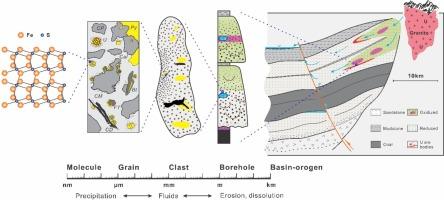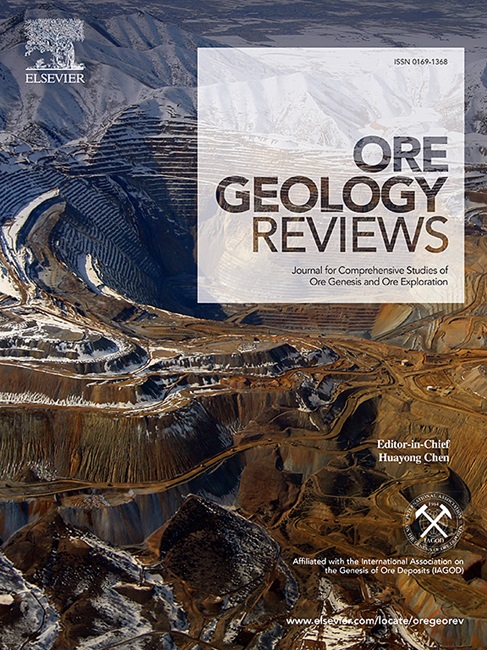鄂尔多斯盆地北部东胜砂岩型铀矿床中的黄铁矿:流体演化和铀矿化的影响
IF 3.2
2区 地球科学
Q1 GEOLOGY
引用次数: 0
摘要
鄂尔多斯盆地北部侏罗系中统直罗地层含铀矿床砂岩中框闪黄铁矿的出现特征、内部形态模式、尺寸变化和微量元素含量综合显示了三种类型的框闪黄铁矿:(i) Py1为合沉积成因,其特征是与粘土矿物紧密结合,微晶大小相等,呈球状或八面体状,框闪黄铁矿和微晶的直径分别为2.1 至 9.3 微米(平均值 = 5.9 微米)和 0.1 至 1.4 微米(平均值 = 0.5 微米),微量元素含量相对较低(平均值 = 0.83 wt%);(ii) Py2 是早期成岩成因,其特征是大小相等的黄铁矿微晶,而其他物质也出现在框胞内,或者微晶的大小和形态不均匀,框胞和微晶的直径分别为 7.3 至 26.3 µm(平均值 = 11.8 µm)和 0.3 至 1.9 µm(平均值 = 0.8微米),微量元素组成与Py1相似;(iii) Py3为铀矿石阶段产地,其特征为大小相等的立方微晶呈松散堆积状,微晶之间充填有含铀矿物,边框体和微晶的直径从7.微量元素含量最高(钴、镍、砷、钼和硒的平均含量为 1.07 wt%)。在矿化过程中,Py1 和 Py2 被层间氧化液溶解,为直径更大的 Py3 的沉淀提供了 S 源和微量元素。Py3的还原能力强、比表面积大、内部孔隙率丰富,有利于通过还原或吸附作用将铀固定在Py3的间隙中。负硫同位素组成表明铀矿化的生物氧化还原过程。框架黄铁矿不同阶段的形成和转化关系表明了合成沉积流体、早期成岩流体和铀成矿流体的复杂演化过程。本文章由计算机程序翻译,如有差异,请以英文原文为准。

Framboidal pyrite in Dongsheng sandstone-hosted uranium deposit, northern Ordos Basin: Implications for fluid evolution and uranium mineralization
Occurrence characteristics, internal morphology patterns, size variations and trace elements contents for framboidal pyrite in the sandstone of middle Jurassic Zhiluo Formation hosting U deposit in the northern Ordos Basin collectively demonstrate three types of framboids: (i) Py1 is the synsedimentary origin, characterized by the close association with clay minerals, equal-sized microcrystals with globular or octahedral shape, the diameter of framboids and microcrystals ranging from 2.1 to 9.3 µm (mean = 5.9 µm) and from 0.1 to 1.4 µm (mean = 0.5 µm), respectively, and relatively low trace element contents (mean = 0.83 wt% of Co, Ni, As, Mo in total); (ii) Py2 is the early diagenetic origin, characterized by equal-sized pyritohedral microcrystals while other substance also occurs within the framboid, or non-uniform size and morphology of microcrystals with the diameter of framboids and microcrystals ranging from 7.3 to 26.3 µm (mean = 11.8 µm) and from 0.3 to 1.9 µm (mean = 0.8 µm), respectively, and similar trace element compositions with Py1; and (iii) Py3 is the U ore-stage origin, characterized by equal-sized cubic microcrystals in the loosely packed pattern with U-bearing minerals filling between microcrystals, the diameter of framboids and microcrystals ranging from 7.6 to 27.4 µm (mean = 15.9 µm) and from 0.7 to 3.2 µm (mean = 1.5 µm), respectively, and the highest trace element contents (mean = 1.07 wt% of Co, Ni, As, Mo and Se in total). During mineralization, Py1 and Py2 are dissolved by the interlayer oxidation fluid, providing S source and trace elements for the precipitation of Py3 with larger diameter. Its strong reducing ability, large specific surface area and abundant internal porosity facilitate the fixation of U in the interstices of Py3 through reduction or adsorption. Negative sulfur isotope compositions suggest biogenic redox processes for U mineralization. The formation and transformation relationship of different stages of framboidal pyrite indicates the complex evolution process of synsedimentary, early diagenetic and U ore-forming fluids.
求助全文
通过发布文献求助,成功后即可免费获取论文全文。
去求助
来源期刊

Ore Geology Reviews
地学-地质学
CiteScore
6.50
自引率
27.30%
发文量
546
审稿时长
22.9 weeks
期刊介绍:
Ore Geology Reviews aims to familiarize all earth scientists with recent advances in a number of interconnected disciplines related to the study of, and search for, ore deposits. The reviews range from brief to longer contributions, but the journal preferentially publishes manuscripts that fill the niche between the commonly shorter journal articles and the comprehensive book coverages, and thus has a special appeal to many authors and readers.
 求助内容:
求助内容: 应助结果提醒方式:
应助结果提醒方式:


